Battle of Saint-Privas - Gravelotte
Battle preparation
The 2 Army Corps, which did not participate in the battle of Mar-la-Tour, continued their advance towards Meuse. On the left wing, the avant-garde of the 4 corps was pushed toward Tula. This French fortress covered the important railway for further operations. The fortress had a small garrison and it was planned to take it on the move. However, on the move to take the fortress failed. The field artillery could not breach the bastions protected by stone, and the wide moats with water made impossible a quick assault. It was also not possible to break the gate to enter the fortress. As a result, the immediate assault Tule refused.
On the morning of August 16 in Pont-à-Mouzon, the army’s main apartment received news that the 3 Corps was engaged in a serious battle and that the 10 and 11 Corps went to its aid. It became obvious that the French had closed the route of retreat, but one should have expected that they would take serious measures to break through. Therefore, the 12 Corps was ordered to move to Mars-la-Tour, and the 7 and 8 Corps were to be ready at Corney and Ars on the Moselle. In addition, the headquarters of the 2 Army sent an order to the Guards Corps to immediately march to Mars-la-Tour. The execution of these orders was facilitated by the initiative of the corps commanders themselves, who received news of the battle. By 18 August, the Prussian command concentrated forces of the 7 corps (7, 8, 9, 3, 10, 12 and Guards) and 3 cavalry divisions of the 1 and 2 th armies.
At dawn 17 August, the French guard posts were all the way from Brivilles to Rezonville. The reports of the Prussian cavalry were contradictory: it was impossible to understand whether the French were concentrating at Metz or departing along both free roads through Ethen and Brie. However, there was no preparation for the offensive. As a result, it became clear that 17 August, the French troops have not yet begun to retreat. In fact, the French were preparing for defense, they dug trenches and trenches all night from 17 to 18 in August, and strengthened their defensive positions in every way. In addition, they occupied the village of Saint-Privas, in which there were many tall stone buildings.
The Prussian command prepared two plans of attack: 1) in both the left wing was to advance northward to the nearest retreat route open to the French through Doncour. In case of detection of the withdrawal of the French army, they should be immediately attacked and delayed until the right wing was suitable for support; 2) If it became clear that the French remained with Metz, then the left wing would have to go east and cover their position from the north, while the right wing would connect the enemy with battle. A feature of this battle was the fact that both opponents fought with the front turned, having no connection with their communications. The French army was now front to France, and the Prussian - to Germany. As a result, the results of victory or defeat could have a more serious meaning. Moreover, the French troops still had the advantage of having a powerful fortress and its facilities as a base.
Painting of the German battle-painter Karl Rehling "Attack at Gravelotte"
The French Marshal Bazin found it inappropriate to retreat to Verdun, since the Germans were already very close to his flank, and decided to concentrate his forces on a position near Metz, which he considered practically impregnable. This position was represented by a ridge of heights, accompanying the valley of Chatel from the west. A wide slope facing the enemy was flat, and a short and steep reverse slope provided shelter for reserves. The crest of these heights from Roncourt to Rosieriel for more than 1 1 / 2 miles occupied the 6-th, 4-th, 3-th and 2-th corps. One brigade of the 5 Corps stood at Saint-Ruin in the Moselle Valley, cavalry was behind both flanks. Guards Corps was left in reserve at Plapevil. Best of all, the defense was prepared on the left flank: before the 2 and 3 corps rifle trenches were quickly dug, batteries and communication lines were arranged, and the individual yards ahead were turned into small forts. On the right flank, the situation was worse. The 6 body did not have a barb tool and could not build strong field fortifications. However, here the French had powerful strongholds Saint-Privat and Amanviler.
Battle of Saint-Privas - Gravelotte
On the morning of August 18, Prussian troops began to move. According to the plan Moltke, who advised to look for the main forces of the enemy and put pressure on them, the German army moved forward. At noon, the battle began in the center at Verneville, where the 9 corps was advancing. Having taken comfortable positions, French troops bombarded German soldiers with Chasspo rifles from a distance of 1200 m, being outside the actual fire of their needle guns. German troops were built in the field, open to the eyes of French soldiers, and suffered losses not only from artillery, but also from gunfire before entering into battle. As a result, German troops suffered serious losses. Particularly affected German artillery, which advanced to the forefront.
About 2 hour. in the afternoon, the Hessian Division arrived to help the 9 Corps. She pushed five batteries to the left on a position on both sides of the railway, which somewhat distracted the concentric fire of the French. This allowed to pull back to regroup part of the artillery of the 9 corps. In addition, artillery of the 9 and Guards corps arrived to the aid of the 3 Corps. Thus, an artillery fist of 130 guns was formed ahead of Verneville and up to Saint-El, which fought the French artillery with visible success. The 3 Corps arrived at Verneuilles, and the 3 Guards Brigade arrived in Gabonville, which greatly strengthened the center of the German army.
The main forces of the Guards Corps are around 2 hour. afternoon approached saint el. However, the commander of the Corps Pappe discovered that, making the entry to the east, he did not go to the right wing of the French army, which was to be covered, but, on the contrary, he substituted his left flank under the blow of the French who occupied Saint-Marie. This village with very strong urban-type buildings, it was necessary to take earlier further movement. After the artillery of the Saxon corps arrived, about 3 an hour. 30 min. Prussian and Saxon battalions rushed to the village from the south, west and north. The French garrison was knocked out, losing several hundred prisoners. Attempts by the French troops to repel a lost position were reflected.
In the center, the 9 Corps managed to capture the Champenois farm and gain a foothold there, but all attempts to advance further with individual battalions and companies against the close front of the French army could not be successful. Thus, to 5 hour. the evening in the center of the active battle completely stopped, the artillery only from time to time exchanged shots.
German field battery Krupp guns in the battle of Gravelotte - Saint-Privat. These guns helped the Prussians well in battle, suppressing enemy artillery fire and destroying the houses in which French soldiers were hiding.
On the right flank of the German artillery of the 7-I and 8-th corps (16 batteries) began the battle on the position to the right and left of Gravelotte. The French were pushed aside from the eastern slope of the Mansa valley and the German artillery group, which had grown to 20 batteries, strongly acted against the enemy’s main position. Many French batteries were put down. About 3 hour. the farm Saint-Hubert, lying directly in front of the main position of the French army and turned into a strong stronghold, was taken by storm, despite the strong fire of the French. However, further movement in an open field failed and led to great losses of the Prussian troops. Only on the extreme right wing of the German army, the 26-I brigade took Jusi and provided the army with messages from Metz. However, the team was not able to go deep valley Rozarel. Thus, the advanced units of the French army were pushed aside, their forward strong points fell and burned. The French artillery seemed depressed.
At about 4 hours, the commander of the 1 Army, General Karl Friedrich von Steinmetz, ordered the offensive to continue. Four batteries and behind them the 1-I cavalry division moved forward along the defile east of Gravelotte. However, the Prussians fell under a concentrated rifle-artillery fire and, after suffering heavy losses, retreated. After that, the French troops launched a counterattack and pushed the Prussian units back. Only the entry of new German units into battle forced the French to return to the main position. Attempts by the Prussian troops to launch a new offensive on a plateau devoid of cover were not successful. By 5 hours there was a break in the fighting, when the exhausted troops of both sides were settled and rested.
At this time, the Prussian king Wilhelm with headquarters went to the army and ordered the 1 army to make a new offensive and handed over to General Steinmetz the 2 corps, which had just arrived after a long march. The French command, to the aid of the attacked 2 Corps, advanced a division of guards voltigeurs (light infantry). Artillery also strengthened. As a result, the Prussians met with strong rifle artillery fire, which in the open area literally devastated their ranks. Then the French themselves went on the offensive with thick rifle chains and pushed aside small parts of the Germans, who were lying in an open field and lost their superiors, back to the edge of the forest. But this French counterstrike was stopped. A fresh Pomeranian 2 corps arrived, which had not yet participated in the battles. True, it was better to hold fresh troops at dusk and use them the next day. Thus, the Pomeranians repelled the counter-attack of the French, but did not have any success in the offensive, the battalions of the 2 Corps were partially disorganized by turmoil among the 1 Army units that were already in combat. The onset of darkness stopped the battle. The fire stopped completely around the 10 hours.
Thus, on the right German flank, despite the courage of the German troops and their heavy losses, the French were only able to push out the advanced fortifications, but they failed to break into their main line. The left wing of the French army was almost impregnable by nature and fortifications.
"Last cartridges". Painting by French artist Alphonse de Neville
Fight in the area of Saint-Privat. On the left German wing fights also took on a fierce character. Around 5 hours in the afternoon, an guard was attempted to storm the village of Saint-Privas. However, the troops of the Guard Corps encountered the positions of the 4 and 6 of the French corps. The strongholds of this front, Saint-Privat and Amanvillers, were almost not fired upon by the German batteries, which so far were fully occupied in fighting the French artillery outside the villages. Ahead of the main French line, located along the ridge of heights, behind hedges and low stone walls, were numerous shooting chains. Behind them was located the village of Saint-Privat, its massive stone houses resembling a castle. Therefore, the open plain in front of the French front was well-swept. As a result, the Prussian troops suffered heavy losses. In the course of half an hour, five battalions lost all, the rest of the battalions - the majority of their officers, especially the senior commanders. Thousands of dead and wounded marked the trail of Prussian battalions.
However, the Prussian Guard was advancing, despite the bloody losses. Senior officers were replaced by junior lieutenants and ensigns. The Prussians ousted the French from advanced fortifications. In the 7 hour, the Prussians reached Amanviller and Saint-Privat at a distance of 600-800 meters. In places at the steep slopes and in the rifle trenches purified by the French, the exhausted troops stop to take a breath. With the help of the arrived 12 Guards batteries, the Germans steadfastly reflected the counterattacks of the French cavalry and infantry. Having suffered great losses, having two French corps directly in front of it, the Prussian troops had a very hard time with the arrival of reinforcements. Only by 7 hour. evenings two Saxon infantry brigades arrived at the scene of the battle; the other two gathered at Roncourt, where artillery fired on this village long ago.
After receiving the news that the Germans were striving to cover his right wing more deeply, Marshal Bazin at 3 hours of the afternoon ordered the Guards Grenadier Division of Picard, concentrated at Plapeville, to go there. This reinforcement had not yet arrived, when Marshal Canrober, fearing even greater pressure from the Prussians, decided to more closely concentrate his forces around the Saint-Privat stronghold. The retreat from Roncourt was to be covered by a weak rearguard. Therefore, the Saxons did not meet the expected strong resistance from Roncourt. After a light battle, the Saxons, together with the mouths of the extreme left wing of the Guard, took the village. Then part of the Saxons turned from the direction of Roncourt to the right, and moved to the aid of the guard directly on Saint-Privas.
The concentrated 24 fire of the German batteries produced terrible havoc at Saint-Privat. Many houses were engulfed in flames or collapsed from grenades falling into them. The French decided to stand to the deaths, defending this most important stronghold. The French batteries north and south of the village, as well as rifle chains, restrained the advance of the Prussians and Saxons. However, the Germans stubbornly moved forward, inflicting bayonet strikes or making a quick fire, although they suffered serious losses. Finally, with the support of the arrived detachments of the 10 Corps, the last assault was carried out. The French defended themselves with the greatest perseverance, despite the burning houses, while, being surrounded, were forced into the 8 hour. lay down weapon. About 2 thousand people were taken prisoner.
Broken parts of the 6 of the French Corps moved to the Moselle Valley. At this time, the French Guards Grenadier Division approached and turned to the east of Amanvillers, along with the army artillery reserve. German artillery fought with the enemy, the firefight lasted until dark. The 4 th French Corps, snapping back with short counterattacks, also retreated. The case reached hand-to-hand fights with the attacking battalions of the right wing of the guard and the left wing of the 9 corps.
Picture of Ernst Zimmer "Attack of the 9 th battalion of Saxon rangers"
Results
Both sides had roughly equal forces. The German army had about 180 thousand soldiers with 726 guns. The French put about 130-140 thousand people with 450 guns. But in the Metz area there were additional forces, which increased the French army to more than 180 thousand people. At the same time, the French occupied well-fortified positions, especially on the left flank. But during the battle at Saint-Privat, Bazin did not appear on the battlefield, practically did not give any necessary orders or reinforcements, did not bring in artillery and other reserves, leaving the battle to chance. As a result, the battle was lost by the French, despite the exceptional heroism and resilience of the French soldiers.
The Prussian army somewhat pressed the French on its right flank and in the center, but could not break through the heavily fortified basic position of the French army in the Gravelotte area. After a fierce battle, on the left German flank, the Saxons and the Prussian Guard were able to capture the strong stronghold of Saint-Privas. This battle, as well as the bypass movement of the 12 Corps, created the threat of reaching the right french flank. The French, frightened of losing contact with Metz, began to retreat to him. In the battle of Saint-Privat - Gravelotte especially distinguished German artillery, which suppressed the French batteries and actively supported the attacks of their infantry. The French lost about 13 thousand people in this battle, the Germans lost more than 20 thousand soldiers, including 899 officers.
The battles of Mars-la-Tour and Saint-Privas were of strategic importance, as they completed the defeat of the Rhine French army. “Although the threat of such a final catastrophe was evident for several days already,” Engels wrote on August 20 under the fresh impression of the five-day battles that took place on August 14 — 18 in Metz, “it is still difficult to imagine that it really happened. The reality has surpassed all expectations ... The military power of France seems to have been completely destroyed ... We cannot yet assess the political results of this enormous catastrophe. We can only be surprised at its size and surprise and admire how the French troops transferred it. ”
Having retreated to Metz, the French troops were blocked there and lost the ability to actively conduct military operations to defend the country. The German command initially did not plan to block the Mets with large forces. It was supposed to attack Paris past the fortress, confining itself to one observation of it, appointing a reserve division for this. However, a completely different force was required for the blockade of the whole army. For the Mets taxation, a separate army was formed under the leadership of Friedrich-Karl, consisting of 1, 7 and 8 corps of the former 1 army and 2, 3, 9 and 10 corps 2 th army, then from the reserve division and 3 cavalry divisions, total 150 thousand people.
The Guards, 4 and 12 corps, as well as the 5 and 6 cavalry divisions formed a special Maass army with a force of 138 thousand people. The Maass and 3 Army, numbering 223 thousand, were assigned to attack the new French army that was formed at Chalon.
It is worth noting that the blockade German army was weaker than the blocked enemy. French troops numbered 190-200 thousand people. However, the French were demoralized. And their attempts to break through the defenses of the enemy were poorly organized, conducted by separate detachments, and were unsuccessful. By mid-October, the French army, besieged in Metz, was running out of food. October 27 The 1870 of Bazin, along with its entire large army, capitulated.
"Cemetery in Saint-Privat". Alphonse de Neville
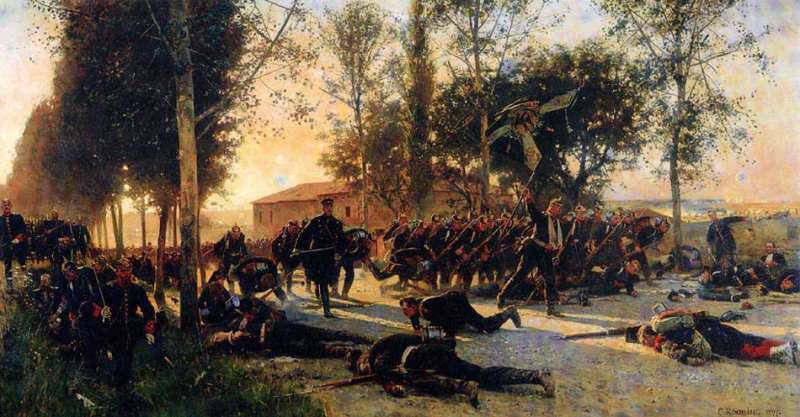
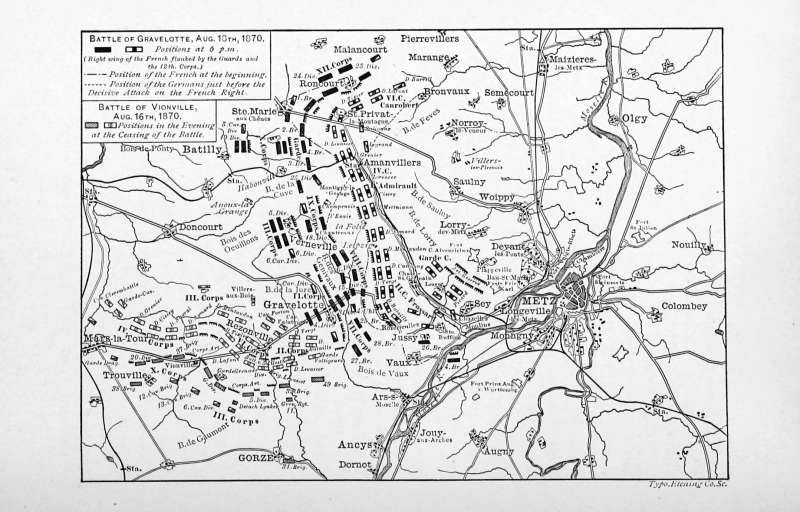
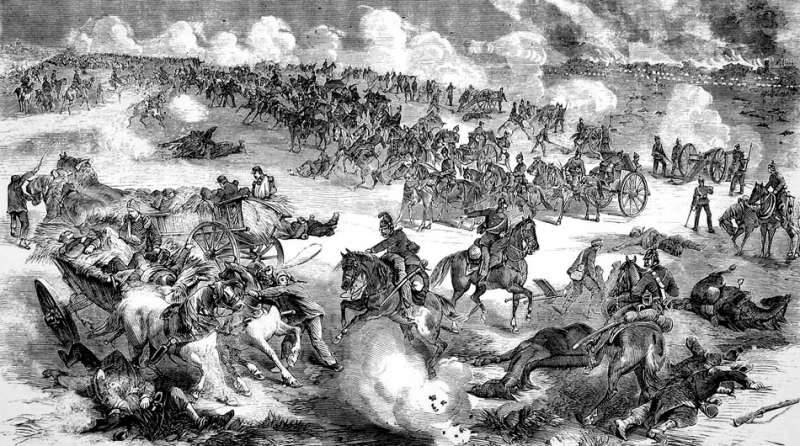
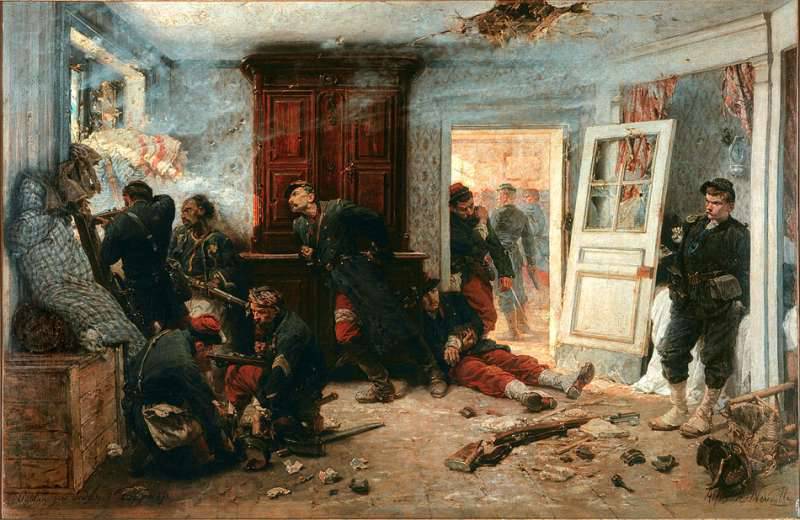
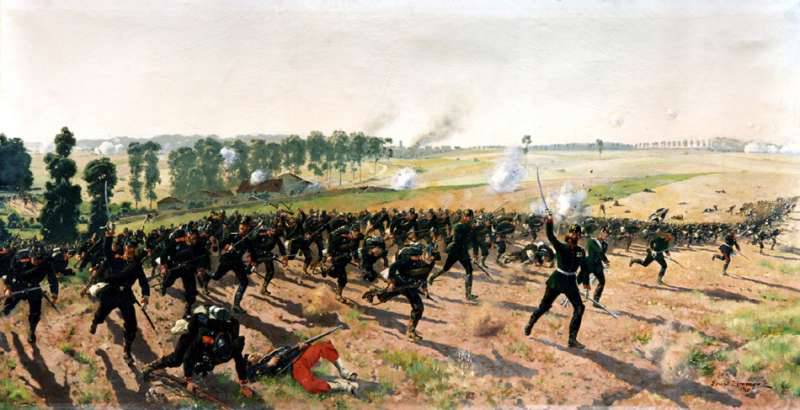
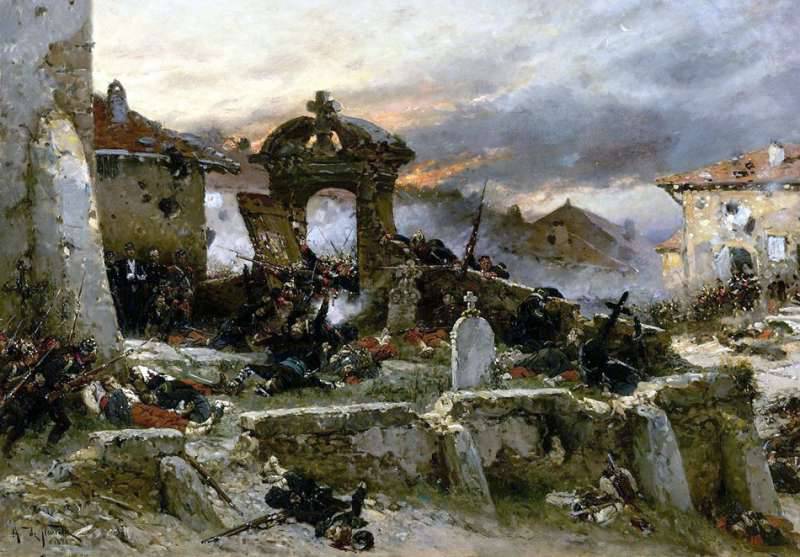
Information